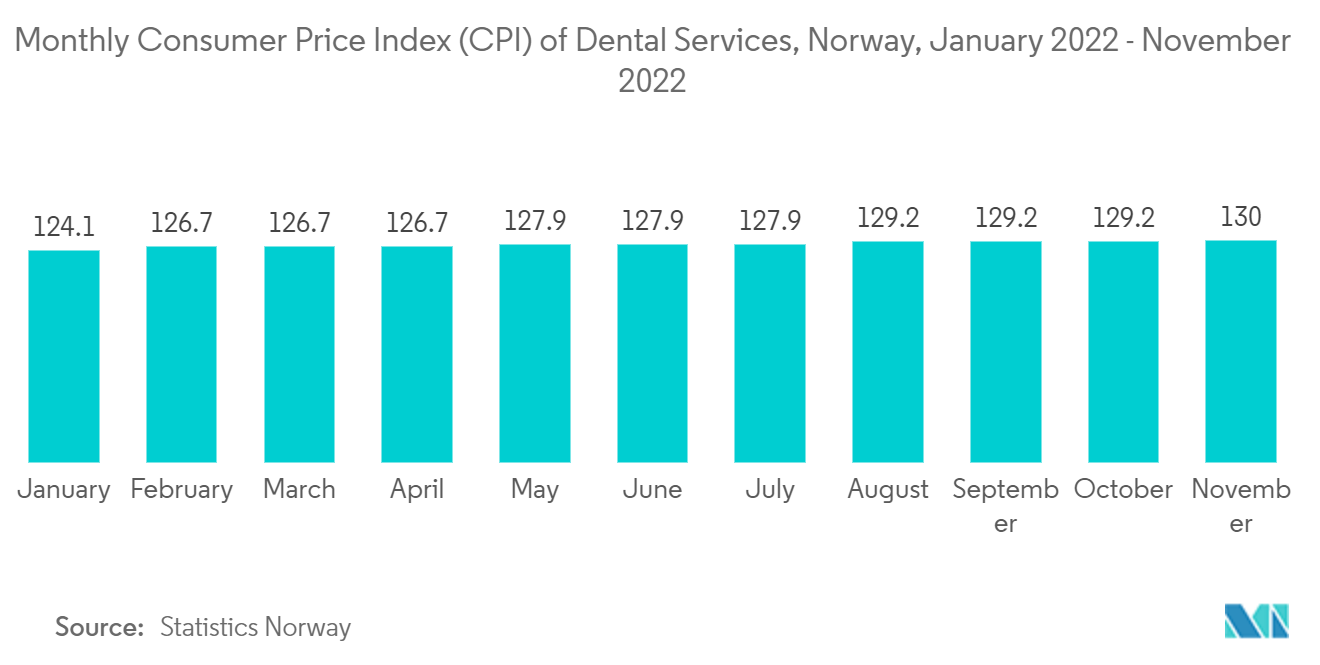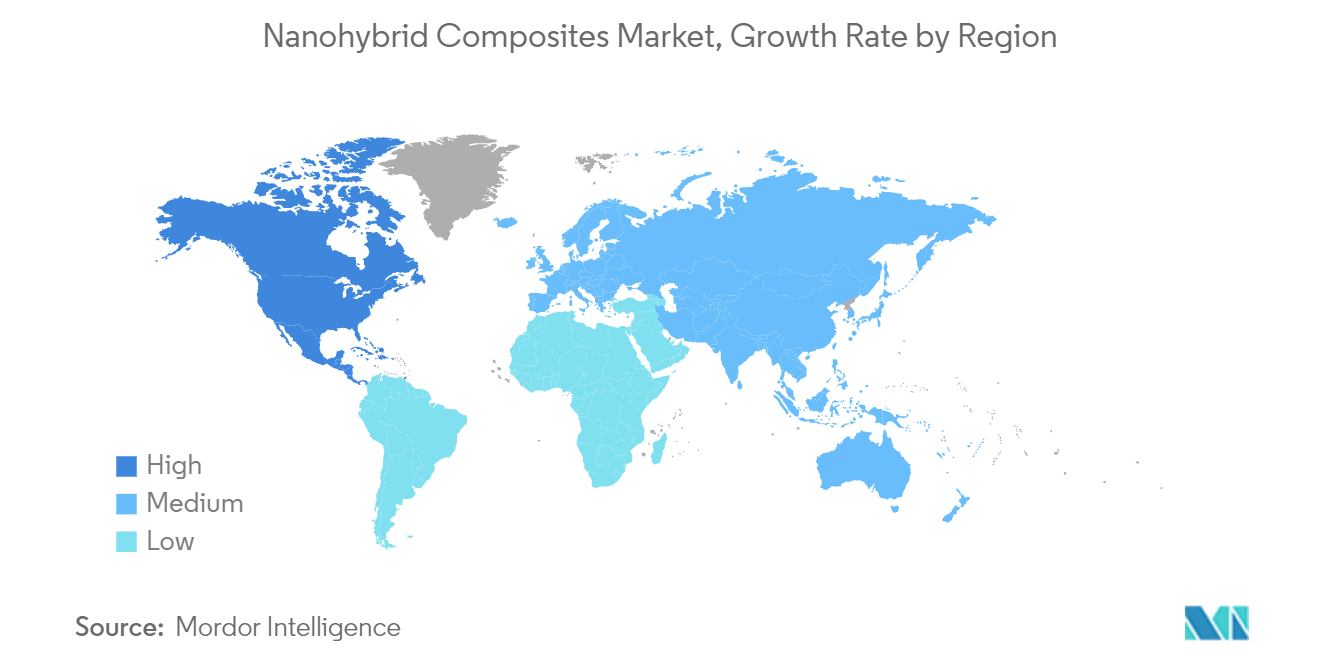Market Trends of Nanohybrid Composites Industry
Progressive Usage of Dental Materials Rises the Demand for the Market
- Due to their use as dental materials, demand in the dental industry has pushed the market for nanohybrid composites.
- On the other hand, the dental material application segment is expected to grow significantly. Larger particles encircling nanometer-sized particles make up nanohybrids. Although the compositions of various materials differ, the purpose is the same: to create a "universal" dental composite. Nano-hybrids mix nanoscale particles with more traditional filler technologies.
- Experimental inserts for teeth were recently created using hydroxyapatite (HAp) nanoparticles to combine their bioactive potential with cosmetic restorative materials. In recent years, controlled porous biphasic hydroxyapatite/tricalcium phosphate, monophasic dense hydroxyapatite, and composite hydroxyapatite/zirconia dental inserts have been manufactured and evaluated for use as dentine replacements.
- The hardness and fracture toughness of the obtained bioceramic implants were within the range of values for human dentine. In vitro, these inserts were demonstrated to lower the polymerization shrinkage of insert-containing restorations and modify the shrinkage vectors of surrounding resin-based composites, potentially functioning as a central stress reduction.
- The most recent generation of nanohybrid composites, which were brought to the market a few years ago, combines the best of both materials to provide long-lasting restorations with a high gloss finish to the teeth. This is critical for improved esthetics and reduced plaque buildup.
- Dental nanohybrid composites using silica sand are tooth-colored filling materials used to treat cavities and other dental abnormalities, providing a long-lasting and aesthetically acceptable alternative for dental restorations.
- According to Statistics Norway, the Consumer Price Index (CPI) for dental services in Norway has risen over time. In November 2022, the index value was 130. The Consumer Price Index (CPI) for dental services in Norway climbed dramatically until February 2021.
- All the aforementioned factors are expected to drive the dental materials segment, which will also enhance the demand for nanohybrid composites during the forecast period.

North America Region to Dominate the Market
- The global nanohybrid composites market is divided into seven geographical areas. North America has the biggest market share and will be the top user of nanohybrid composites during the projection period.
- The United States is predicted to increase at a modest rate throughout the projection period. Increasing disposable income in emerging nations is driving demand for convenience items, helping the growth of the worldwide nanohybrid composites market.
- Nanohybrid composite materials are rapidly being used in a wide range of engineering applications due to their superior features and benefits over standard composite materials. n (n > 2) cooperatively functioning phases determine the mechanical characteristics of hybrid composites. As a result, as previously stated, the mechanical characteristics of nanohybrid composites are modeled using a linear coupling of numerical simulation models.
- A variety of dental composite fillings are developed to provide dentists with essential benefits like adaptability, aesthetics, strength, and clinical confidence while performing any restorative surgery, anterior or posterior. There are a variety of nano-hybrid composite resins advanced to real nanotechnology, depending on the handling or procedure preferences. The nanocomposites provide excellent aesthetics while maintaining the control and predictability that you want in your processes.
- Microhybrids and nanohybrids used to be a substantial advance over earlier microfills. Since then, it has raised the standard with composite resins that use nanotechnology, allowing dentists to provide patients with clinically proven, long-lasting dental health and natural-looking aesthetics. Nanohybrids, like micro hybrids, feature separate big and tiny particles, but their average particle size is somewhat smaller. For general usage, but mostly on the back teeth.
- According to the American Dental Association, in 2021, the United States were expected to have 159,246 general practice dentists and 10,921 orthodontic and dentofacial orthopedic dentists. This statistic depicted the number of professionally active dentists working in the United States in 2021, organized by specialty.
- The incorporation of nanohybrids into organic coatings may improve barrier effectiveness by lowering porosity and zigzagging the diffusion path for harmful species. Consequently, nanohybrid-containing coatings are predicted to offer considerable barrier qualities for corrosion protection and to lessen the coating's tendency to blister or delaminate.
- According to the American Coatings Association, the paint and coatings industry in the United States was expected to produce around 1.36 billion gallons in 2022. In 2023, the industry's output was expected to exceed 1.38 billion gallons.
- Nanohybrid composites are used in electrical and electronic applications such as insulation, dielectric, energy harvesting, batteries, and space exploration. According to Forbes, NextEra Energy, headquartered in Florida, was the largest electric utility company in the world in 2022, with a market value of USD 145.27 billion. Duke Energy came in second with a market value of USD 105.4 billion.
- As a result, all the causes listed above are projected to increase demand for the nanohybrid composites market in the North American region in the future.


